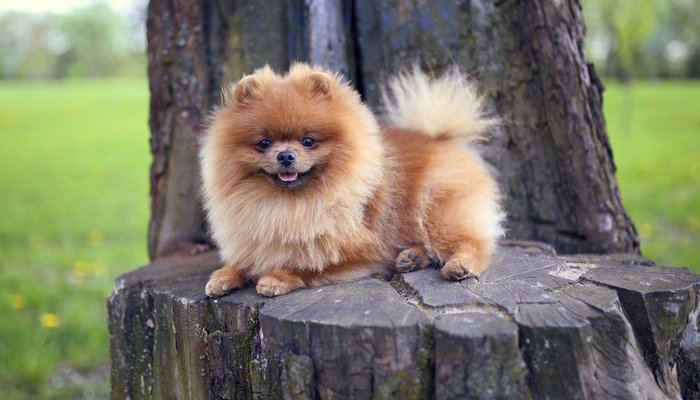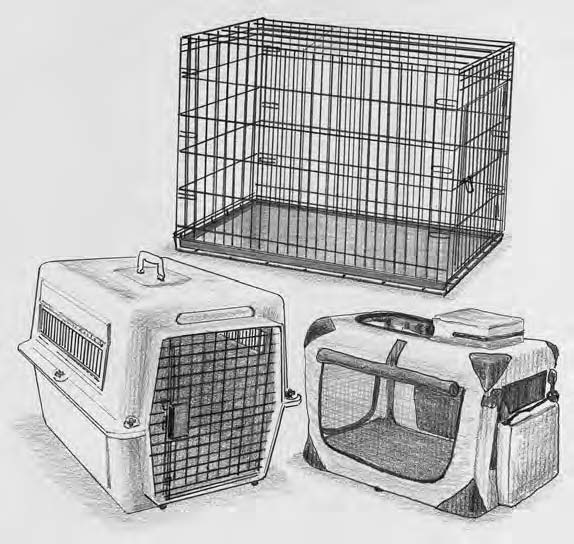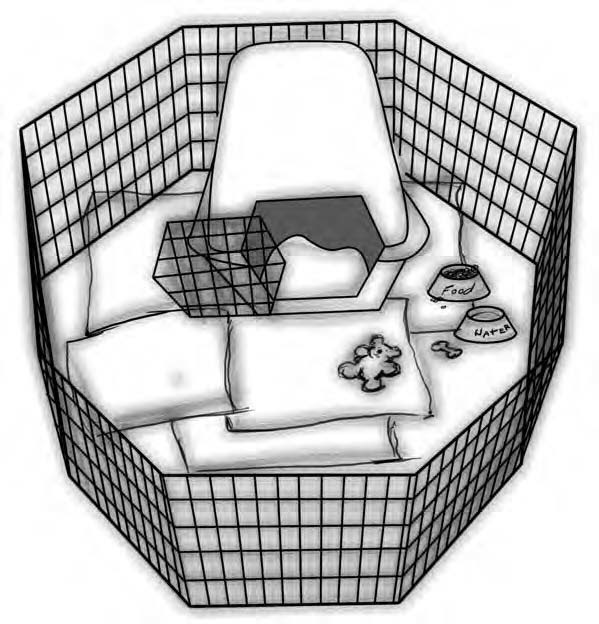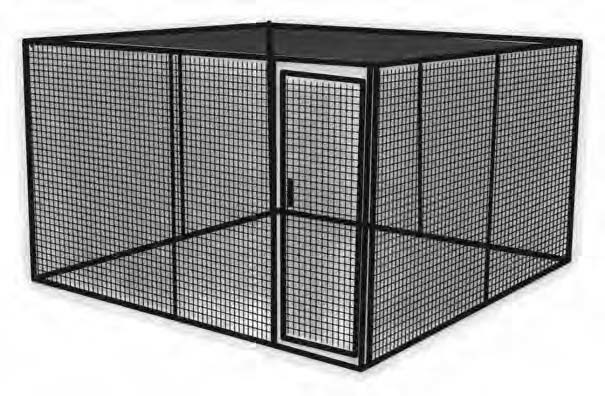In This Chapter
- Purchasing the gear and setting up house
- Preparing your home and yard to be accident free
- Introducing . . . your new veterinarian
Collecting Pom Paraphernalia
Housing and transporting
Crate
– Wire: Wire crates are easy for you to collapse (especially the ones designated suitcase design). Be careful not to throw your sweater or other valuables on top of the wire crate when it’s occupied. An industrious dog can pull most materials through the grating — not a fashionable look when she’s finished with it.
– Plastic: Plastic crates were developed for airline travel. They’re very cozy but they don’t allow the visibility and ventilation of wire crates.
Tip
– Cloth: Cloth crates are only for dogs that have been cratetrained; unsupervised puppies have a habit of chewing and digging their way out — not good for them or you.
Remember
The crate is the puppy version of a toddler’s crib. Use it at his naptime and when you can’t watch him, but never as a punishment or a place to store him when you’re not interested in him. If you plan to use the crate as your babysitter when you’re at work all day, every day, you need to rethink getting a dog.
Exercise pen
Tip
The solution is an indoor yard or exercise pen (also called an X-pen; see Figure 5-2). This is a 4-x-4-foot pen that’s typically wire. They come in different heights, but a 2-foot-high pen is fine for your little goofball. In fact, a baby’s playpen works well as an indoor X-pen for small dogs. (If you have a baby that still uses it, this idea won’t work; you’ll be vacuuming it constantly!)
Warning!
You can take the X-pen outside if you want your puppy confined in the yard. In this case, a wire top for the pen (sold separately) is particularly handy. Pom puppies are so tiny that large mammals and birds consider them prey. A secure top may not dissuade a coyote, but it can stop an eagle from swooping down and carrying off your dog. Also be sure she has shade and remember to check on her often. Better yet, sit outside with her.
Carrier
– On trips to the veterinarian
The carrier helps her feel more secure and makes your job far easier because you’re not trying to hold her on your lap or keep her from running up to the other patients.
– For your regular walks in case you ever need to swoop her up to safety
– Of course, for that stroll down Rodeo Drive
Car-safe restraints
Dining ware
– The best bowls are of stainless steel because they’re easy to clean and impossible to break.
– Ceramic has the advantage of being microwavable in case of leftovers, but it can crack.
– Plastic bowls are generally the worst choice. They scratch, and the tiny scratches are hard to clean. In addition, a few dogs have allergic reactions to them and develop a pinkish nose when they eat from plastic.
Walking supplies
Collar
Warning!
Never leave the collar on her unattended because she can easily get her lower jaw stuck in it. Don’t ask how — they just manage to do it!
Leash
Warning!
Avoid chain leashes because they feel like an anchor on your Pom puppy’s neck. They’re also good at whacking the dog in the face.
– People are careless with these leads. When they let the dog wander to the end of the extended leash and she makes a sudden turn, she ends up in the road, splattered by a car. Or she runs up to a big dog — and gets chewed up.
– People use these leashes everywhere they take their dogs, but they’re not practical for populated sidewalks and public areas.
– Because dogs have to pull against the leash to extend the leash, they learn to always pull when on leash — even when you don’t want them to.
– If you accidentally drop your end of the leash, the plastic handle scuttles toward the dog, making a racket and often scaring her. If she takes off running, the handle clacks along behind so she keeps running in a panic — a bad situation.
Identification
Chewies and anti-chewies
Warning!
– Chewies: Puppies like to chew. They like to chew your hands, your furniture, your clothes, and your wallet. Fortunately they also like to chew rawhide. For many breeds, rawhide can be a bad idea because the dog rips off hunks, swallows it, and then chokes. As long as you get a rawhide chewy — too big for him to swallow hunks off of — and supervise your Pom as he chews, he should be fine.
– Anti-chewies: You can buy sprays that make an article taste so bitter that your dog practically foams at the mouth when he licks or chews it. Bitter Apple is the best known of these products.
Tools for setting boundaries
Baby gates
You can’t always keep your puppy in a crate or X-pen (see “Housing and transporting” earlier in this section), but you can’t always be chasing her from one room to the next either. The solution is to set up baby gates between rooms. Be sure you don’t use the oldfashioned accordion style, which can close on a puppy’s neck and strangle her. If you have too many doorways or your doorways are too wide for standard baby gates, just prop a long, sturdy piece of cardboard across the opening. (Make sure you can step over it so you don’t have to move it all the time.)
Ramp
Tip
Will you allow your Pom on the furniture? The time to decide is now. If you don’t plan to have her on furniture as an adult, simply don’t lift her up there now. If you want to hold her or play with her, get on the floor with her. (That’s a good idea anyway.)
Fence or kennel
Warning!
What about the underground electric fences that give your dog a warning beep and then a small shock when she gets too close to the boundary? Not a good idea. Although these fences keep your dog in, they can’t keep potentially dangerous dogs out.
Tip
If you plan to leave your dog unsupervised outside, a covered kennel run (see Figure 5-4) is your best choice.
Grooming gear
– A soft-bristle brush is an ideal introduction to grooming.
– A medium-tooth comb helps you reach down to the skin.
– Rinseless shampoo is the best kind for a puppy.
– Medium- and wide-tooth combs
– Slicker brush (a brush with many tiny, bent tines to pull out dead hair)
– Pin brush (a brush with straight tines to fluff the hair)
– Bristle brush (a medium-texture brush is best for Pom coats)
– Scissors (blunt tips are safer for not stabbing your dog)
– Toenail clippers (for dogs — make sure you get the kind for small dogs)
– Mat rake or mat-breaking tool (for getting out mats)
– Water spritzer bottle (to moisten the coat before brushing)
Warning!
Do not leave your dog (any dog!) on any kind of table unsupervised, especially if he’s tethered.
Cleaning up after your pup
– Poop scoop: A poop scoop isn’t your most exciting purchase, but it may be the most useful. And it’s far better than makeshift trowels and buckets because it’s designed to make the job easy.
Tip
When you’re walking your dog down the street, the easiest scoop is a cheap sandwich bag (avoid the thick, zippered ones).
– Carpet cleaner: Get the kind with enzymes because they destroy the odor-causing molecules rather than simply covering them up. Find them at pet supply stores.
– Air freshener: Spray before company comes — assuming you want these guests to come back.
Toys and other fun stuff
– Toys give puppies something to chew on and toss about in place of your valuables.
– Toys help develop puppies’ brains and coordination.
– Puppies that never learn to play with toys tend not to understand toy playing (an important activity throughout their lives) as adults.
Remember
Just to be on the safe side, when you initiate tug games, always end the game after you win. And no matter how weak you are, you surely can win a tug game against a 2-pound puppy!
Tip
Special interactive toys are good distractions for puppies and adult Poms that have to be left alone. These toys challenge your puppy to dislodge sticky food treats, thereby occupying and rewarding him over a long time period. Remove these toys when you return (you can store them in the freezer if they still have food in them) so your dog looks forward to them the next time you leave. Try rotating several interactive toys with different challenges to prevent him from getting bored.
Warning!
Make sure the toys you buy don’t have small pieces that your dog can pull off and swallow, and make sure he can’t burrow into it and discover electronic guts. Avoid bean-filled toys, which can pose a hazard if your dog manages to open them up.
Preparing for Emergencies
Stocking the first-aid kit
– Activated charcoal – Allergy medication – Antidiarrheal medication – Antiseptic skin ointment – Corn syrup – First-aid instructions – Hydrogen peroxide – Instant cold compress – Latex gloves – Liquid bandage | – Ophthalmic ointment – Pen light – Rectal thermometer – Scissors – Self-adhesive (cohesive) bandage – Soap – Sterile gauze dressings – Styptic powder – Syringe – Tweezers |
Making an emergency plan
– Carry the emergency number of your veterinarian with you in your wallet or store it in your cellphone.
– Know where the emergency veterinarian is and drive there beforehand to make sure you know the way. It’s too easy to get lost when you’re in a panic.
– Never leave your car in your driveway with only fumes in the gas tank. The last thing you need is a stop at the gas station so you can make it to the vet.
Designing Spaces Fit for a Small King or Queen
By day
When you’re away
1. Place the X-pen on a dog-proof floor (such as linoleum). For a carpeted floor, lay down an old shower curtain to protect it.
2. Put the crate or bed in one corner of the pen, bowls of food and water in another, and a doggy litter box (see Chapter Saving the Carpets: Housetraining) in another.
3. Throw in some toys and your puppy is ready to kiss you good-bye for the day.
By night
– A soft blanket
– A stuffed animal for cuddling
– A stuffed puppy comforter that has a place to insert a warm pad (You warm it in the microwave before insertion.)
These comforters also make a soft noise that sounds like a heartbeat (much better than trying to slip in a traditional clock!).
– Any creature comforts that make your puppy feel like he’s with M-O-M.
Pom-Proofing Your Home and Yard
Generally speaking . . .
– Exterior doors: Keep all doors securely closed. A screen door is an added safety device. Any open door should have a doorstop so the wind can’t catch it and slam it shut on your puppy.
– Glass doors: Running into a glass door can cause severe injuries. Place stickers on glass doors at Pom eye level so she knows when the door is closed.
– Stairways: A fall on a stairway is like a tumble down a canyon for little Pomeranians. Open-backed steps are an invitation to disaster. Always keep a baby gate (see the earlier section “Tools for setting boundaries”) between steps and your Pom.
– Uncovered electrical outlets: Whatever could be in those tiny holes? If the puppy licks hard enough, she may find out — she may even see sparks. This charge is definitely not good for her tongue or her general well-being. Buy outlet covers at hardware or baby supply stores.
– Electric wires: Do you have a jungle of vinelike wires under your desk? Perhaps you just have an occasional wire to a lamp or phone. That has to be fun to pull on . . . until the lamp or phone comes crashing down on her or your computer goes on the fritz!
– Space heaters: Your puppy can get a painful burn if he gets too close to a hot space heater. He can also knock one over, which just may start a fire. Keep these heaters out of his reach.
– Ashtrays: Put ashtrays and any nicotine products out of reach. Better yet, quit smoking — that second-hand smoke doesn’t do your cute puppy any good.
– Coins: Paper currency may go through your puppy’s digestive system, but coins can be an expensive meal if your puppy swallows them. They may get stuck along the path, or in the case of pennies, sit in the stomach and dissolve, releasing toxic zinc. Your puppy is not a piggy bank! Keep coins away from him!
– Purses: These are a Pandora’s box of puppy perils that may include drugs, cigarettes, coins, and maybe even some pepper spray. Keep purses away from purse-snatching Poms!
– Unattached bookcases, vases, and statues: What’s up there? Puppies like to jump onto just about anything. Make sure she can’t send your oh-so-curious belongings — or the whole bookcase — toppling over, especially onto her.
– Blinds with long cords: Those hanging strings are fun to jump at and tug on until he catches his head in a loop and chokes. Cut the loops, shorten the cords, or buy childproof protectors for them.
Kitchen
– Cabinets: To puppies, cabinets are like secret caves filled with treasure. But the cave holds dangers like poisonous cleaners and degreasers. Remember to either place bad stuff elsewhere or secure all your cabinets with child safety latches.
– Plastic bags, wrap, and aluminum foil: Put these items out of reach. They may be fun to chew, but they sure are difficult to digest.
– Plastic canisters: It was funny when Winnie the Pooh got his head stuck in the honey jar, but if your puppy gets her head stuck in just-the-right-size jar, it can form an airtight seal around her head and suffocate her. It’s happened.
– Puppy underfoot: Puppies fancy themselves gourmet chefs in the making. They want you to shake up all the ingredients, so they run between your feet when your hands are full. And by sticking their heads in the open refrigerator, they also ensure that you don’t close the door too soon. Unfortunately a Pom puppy’s skull probably isn’t as strong as a refrigerator door. Keep the little chef out of the kitchen while you’re cooking.
Dining room
– Swinging door: If you have a swinging door, stop it from swinging or take it off its hinges.
– Hanging tablecloth: Can the puppy jump up and snag the tablecloth? Yes. Can the puppy jump out of the way of the fine china plummeting toward her as she drags the cloth off the table? Maybe.
Family room
– Fireplace without secure fire screen: A fireplace fire is as big as a forest fire to a Pom puppy! He may not realize just how hot it is until his fur is ablaze. And he can catch your house on fire by removing a burning stick and then throwing it down on your papers. Even if you have a fire screen, don’t leave your puppy alone around a fire.
– Sewing or knitting basket and craft kits: Needles and pins can perforate any part of the digestive tract. And thread, yarn, or any long, stringlike object can cause the intestines to accordion, which is potentially fatal. Also, castor beans (used in some beading projects) contain ricin, one of the most damaging chemical toxins of plant origin.
Bedrooms
– Toys: You were careful to buy puppy toys that she couldn’t rip apart and swallow, but what about other stuffed animals she may find around your house? Swallowing parts of toys can cause blockages — not to mention hard feelings with the kids.
– Open closets: Missing a shoe? Whose fault is that? Close the closet door!
– Diaper pail: Yuck! But when you say “Yuck!” your dog says “Yum!” Dogs do eat soiled diapers. Besides the disgusting sight, diaper material can cause blockages. Solution? Keep diaper pails out of reach. Simple.
Bathroom
– Pills: Childproof caps aren’t puppy proof, so he can just gnaw right through. And with his tiny body weight, it takes only a fraction of a pill to wreak havoc on his body. Even small doses of pills like acetaminophen and ibuprofen that are safe for people can be deadly for dogs.
– Toiletries: Razors, perm solutions, hair coloring, suntan lotions, deodorants, and rubbing alcohol are just a few examples of items you need to keep out of your puppy’s reach.
– Drain cleaners: Drain cleaners are designed to dissolve organic material. You puppy is all organic material. Don’t let them mix.
– Toilet with open lid: Your Pom puppy is probably too short to reach, but where there’s a will there’s a way.
Laundry room
Most sensible Poms steer clear of any room that involves work, but sometimes an adventurous one goes exploring And some owners use the laundry room as quarters for their dog. Make sure you spot the dangers before he does.
– Detergents, bleach, and lye: If your puppy finds a box of white stuff, she can have a great time simulating a snowstorm, flinging white powder everywhere. But that powder burns eyes and throats, and bleach can be blinding or fatal.
– Open dryer door: Snatch something out of the dryer, leave the dryer door open, and walk away. Who walks in? Your puppy, looking for a soft, warm place to snuggle. Then you go back and decide you need to dry those clothes a little longer. If the tumbling doesn’t get him, the heat will.
Garage
– Antifreeze: A sweet treat on the garage floor beckons to your puppy. But just one lap of antifreeze containing ethylene glycol can kill him. Even if he merely licks his paws after walking through it, he can become extremely ill. Use only antifreeze with propylene glycol, which has reduced toxicity. And be sure to clean up any spills.
– Fluids: Gasoline, diesel, oil, kerosene, brake fluid, carburetor cleaner, windshield fluid, paints, paint thinners, acetone, mineral spirits, pool chlorine, wood stain, furniture polish, glue, and batteries are all potentially deadly. Keep them up and away.
– Tools: Tools can seriously injure you when they fall on your foot. Imagine what they can do if your puppy knocks one down on his own head. Keep him away from cords and work areas.
– Car: Always check on the dog’s location and put him up before moving the car.
– Garage door: Broken necks and backs can come from garage doors being slammed carelessly, and even automatic doors may not stop in time. Never leave your Pom loose when the garage door is shutting.
– Power tools: Would you let a toddler hang around when power tools are in use? Then don’t let a puppy around.
– Nails, tacks, and screws: These aren’t meant to go inside a puppy’s digestive tract, and they’ll cost you one very large veterinary bill to extract.
– Herbicides, rodent poisons, slug bait. They’re designed not only to kill but also to taste good. But they taste good and kill dogs, too. The fatal effects may show up days later, long after you’ve assumed he’s fine.
– Fertilizers: These have one simple guideline: What’s good for a plant is bad for a puppy.
Outside
Man-made accessories
– Decks, balconies, and upper-level open windows: Most railings weren’t designed to keep tiny dogs from slipping through. Put temporary fencing or other barriers around the edges.
– Unsealed deck wood: Pressure-treated wood contains arsenic; if the wood isn’t sealed regularly, the arsenic can leach out and be toxic to a puppy that licks the wood.
– Weak fence: A weak fence is a ready-made challenge course. Every time your Pom finds a way out, it reinforces his determination to keep trying. Show your pup from the start that this is one challenge he can’t meet. Make sure the fence meets the ground. For Poms that love to dig, extend some wire underground toward the inside of the yard.
– Unfenced pool: Just like toddlers, dogs can fall in swimming pools and drown. They may swim for a while, but when they get too weak to hang on to the side, they eventually go under. Keep the pool securely fenced, give him swimming lessons, make sure there’s a way out, and make sure he knows how to find the way out.
All things natural
– Predators: Don’t let your small puppy outside alone, and consider a mesh-top exercise area (refer to Figure 5-4) if large eagles and other birds of prey are around. Other predators include
- Coyotes and mountain lions that look for an opportunity to snatch a small dog if he’s alone in the yard
- Alligators that consider dogs a delicacy
- Unfortunately, bad people who may want to steal a Pomeranian puppy
– Wild animals: Beware of poisonous snakes, snapping turtles, giant marine toads, and various animals that may injure a curious puppy in self-defense. Inspect your yard for insect hives, underground nests, and fire-ant mounds.
– Treated lawns: Wait at least 24 hours before letting your puppy on a treated lawn or around treated bushes.
– Nut trees: Nuts can be fun to play with and even to crunch on. But the nuts can cause blockages and have to be surgically removed.
– Poisonous plants: Many plants can be bad for your puppy. To be on the safe side, don’t let her graze among yours. Check your plants against the complete listing online at www.aspca.org or consult with your veterinarian. Some common poisonous plants include
|
|
– Tree limbs: Rotted limbs can fall on a small dog, killing him. Even falling fruits and pine cones can hit a dog in the head with fatal results.
– Cocoa mulch: Cocoa mulch has a sweet taste, but it contains theobromine, the same ingredient in unsweetened and semisweet chocolate that’s fatal to some dogs.
Exercising caution during holiday decorating
Christmas
Remember
Christmas parties mean lots of opportunities to slip out the door, get stepped on by guests, or be overwhelmed by company. Unattended alcoholic beverages, coffee, chocolates, nuts, illicit drugs, and cigarettes beckon to a curious Pom. Some owners err by tying festive ribbons around Fido’s neck and then letting him play unsupervised. Place him in a secure area or crate during parties or hectic times.
– Mistletoe and Jerusalem cherries are highly toxic, particularly the berries.
– Holly berries are somewhat toxic.
– Poinsettia is not as toxic as most people think, but it still can cause gastrointestinal irritation.
Thanksgiving
Independence Day
Halloween
Finding a Vet and Scheduling the First Appointment
Tip
Before your puppy becomes a regular patient there, check out the facility. Ask for a tour. The clinic should be clean and have safe, sanitary overnight accommodations. Look for American Animal Hospital Association accreditation, which is given only to hospitals meeting certain standards. And of course, the fees shouldn’t make you pass out when you get the bill — at least no more so than the other clinics in town.
by D.Caroline Coile,Ph.D.











